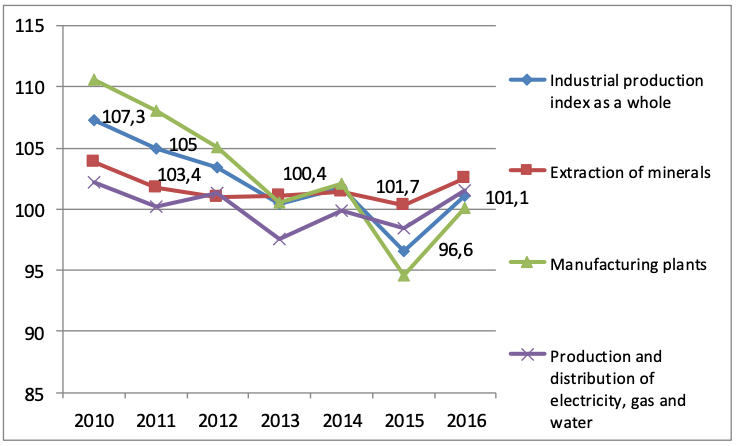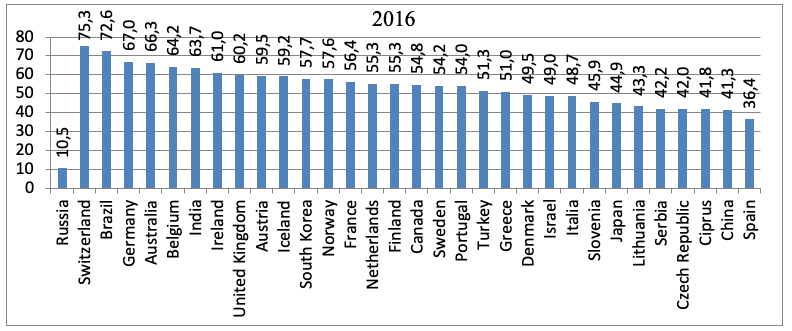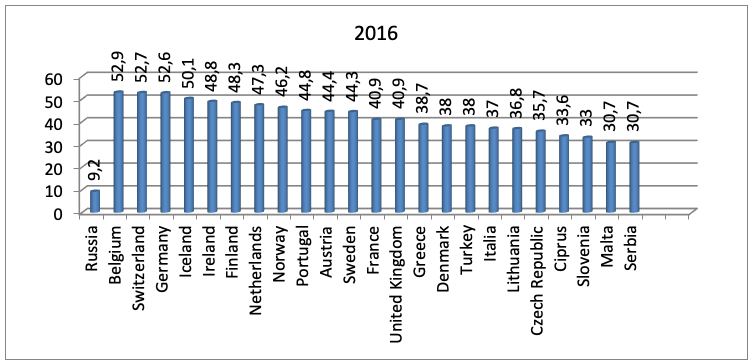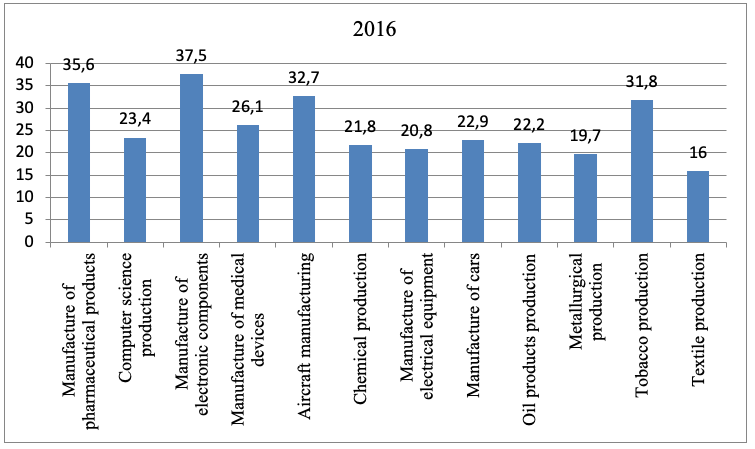

Vol. 40 (Number 16) Year 2019. Page 29
NOVIKOV Sergey V. 1 & GAVRILOVA Inna S. 2
Received: 12/02/2019 • Approved: 21/04/2019 • Published 13/05/2019
ABSTRACT: This article deals with the issue of increasing the efficiency of innovative development of the industry of the Russian Federation in the context of modernization of the economy. It carries out an estimation of the condition and tendencies of development of the domestic industry, giving special attention to the analysis of innovative activity of the organizations of industrial production of the Russian Federation. Furthermore, it reveals the problems and prospects of development of the industrial sector of the national economy. |
RESUMEN: Este artículo aborda la cuestión del aumento de la eficiencia del desarrollo de la innovación en la industria de la Federación de Rusia en el contexto de la modernización de la economía. A su vez, realiza una estimación de las condiciones y tendencias del desarrollo de la industria nacional, prestando especial atención al análisis de la actividad innovadora en la producción de las empresas industriales rusas. Además, revela los problemas y las perspectivas de desarrollo del sector industrial de la economía nacional. |
In modern conditions, the dynamic and progressive development of the industrial sector of the national economy is determined by a new ideological paradigm: competitiveness. According to the Global Competitiveness Index, the Russian Federation ranks 45th out of 127 countries under consideration. Russia ranks 73rd on the criteria of "ability to create and introduce new technologies".
Russia's industrial sector is undoubtedly the basis for the implementation of the innovation strategy for the development of the national economy. Modernization of the Russian industry can be considered as the main point of development of the national competitiveness.
The state of Russian industry in 2016 is characterized by the following data: 450.1 thousand functioning enterprises, 13.3 million people employed, 53228 billion rubles of shipped goods of own production, works and services.
In order to assess the trends in the development of domestic industry, we will analyze the dynamics of the industrial production index as a whole, as well as by types of economic activity (Figure 1).
Figure 1
Dynamics of the industrial production index by types
of economic activity for the period from 2010 to 2016, %

The dynamics of industrial production over the analyzed period is characterized by extreme inequality. If in 2010 - 2014 there was a positive dynamics of annual growth in industrial production, in 2015 there was a significant drop in industrial production indices calculated by the types of economic activity "Manufacturing industries" and "Production and distribution of electricity, gas and water". In 2016, according to Rosstat's operational data, industrial production growth amounted to 1.1% in annual terms. In the extractive sector, industrial output exceeded the 2015 figure by 2.5%, while in the crisis period of 2013-2015 this sector did not leave the positive growth zone.
The share of the extractive industry in the volume of goods shipped averages about 25%; the share of processing industry, 65.0%; the share of electricity, gas and steam supply - 8%; and the share of water supply and waste water disposal, 2%.
Extractive and manufacturing industries of the industrial sector of Russia have specific features, national originality, predetermined by all previous technological and economic development.
The actual characteristics identified by the author in the course of a systematic analysis of the state and trends of development of industry (industrial sector) in Russia are:
- a pronounced raw material orientation of the Russian economy, which is manifested in the predominance of the investment attractiveness and efficiency of the development of the extractive sector of industry;
- low share of high-tech manufacturing industries and high level medium-technology industries, as well as industries focused on consumer products, with a high share of industries and industries included in the defense sector;
- breaking the existing ties between the economic systems. Despite the fact that many politicians and scientists consider the suspension of international cooperation between European states and Russia on political grounds as an advantage for the development of the domestic economy, the isolation of Russia has a negative impact on its investment climate, exchange of experience and technologies with Western countries, which is a fundamental moment for the formation and development of domestic industry;
- aggravation of the technological crisis in the industrial sector of the economy, which manifests itself in a high degree of physical and moral wear and tear of the operating equipment, lack of personnel with new technologies.
Thus, an urgent problem of the modern domestic economy is the imbalance of its structural elements, including in the industrial sector. The leading industries in the Russian industry are the fuel and energy complex, metallurgy and military industrial complex, which emphasizes the raw material nature of the economy. This structure of industry cannot be considered optimal and efficient.
The economic policy at the present stage of development of the society should be based on the transformation of the national industry by means of transition from the "raw material economy" to the formation of competitiveness of manufacturing industries in the domestic and foreign markets of products.
Key indicators characterizing the innovation activity of industrial production organizations of the Russian Federation are summarized and presented in Table 1.
Innovation activity of domestic industrial enterprises in terms of the share of innovation-active enterprises in their total number is rather low. In 2016, the aggregate level of innovation activity of the national industry was only 10.5%, with the average annual rate of change of the indicator under study for the period from 2010 to 2016 being negative (-0.075%) (Table 2).
Such a value of one of the most important indicators of innovative development of the country's economy has a critical level. Comparison of the level of innovation industry in developed countries and Russia is not in favor of the latter. The aggregate level of innovation activity of European industrial sector organizations averages 35-75% (Figure 2).
Figure 2
Comparative characteristics of the total level of innovation
activity of industrial sector organizations by country, %

-----
Table 1
Dynamics of key indicators of innovation activity of industrial production
organizations of the Russian Federation for 2010-2016
Indicators |
Year |
||||||
2010 |
2011 |
2012 |
2013 |
2014 |
2015 |
2016 |
|
А |
1 |
2 |
3 |
4 |
5 |
6 |
7 |
1. Aggregate level of innovation activity, % |
10,8 |
11,1 |
11,1 |
10,9 |
10,9 |
10,6 |
10,5 |
- chain absolute variation, % |
- |
0,3 |
0 |
-0,2 |
0 |
-0,3 |
-0,1 |
- basic absolute variation, % |
0,0 |
0,3 |
0,3 |
0,1 |
0,1 |
-0,3 |
-0,4 |
2. Share of organizations that implemented technological innovations in the total number of organizations, % |
9,3 |
9,6 |
9,9 |
9,7 |
9,7 |
9,5 |
9,2 |
- chain absolute variation, % |
- |
0,3 |
0,3 |
-0,2 |
0 |
-0,2 |
-0,3 |
- basic absolute variation, % |
0,0 |
0,3 |
0,6 |
0,4 |
0,4 |
0,2 |
-0,1 |
3. Volume of innovative goods/works, mln. rub. |
|
|
|
|
|
|
|
- in current prices |
1165748 |
1847370 |
2509604 |
3072531 |
3037407 |
3258255 |
3723693 |
- chain absolute variation, % |
|
158,5 |
135,8 |
122,4 |
98,8 |
107,3 |
114,3 |
- basic absolute variation, % |
100 |
158,5 |
215,3 |
263,6 |
260,5 |
279,5 |
319,4 |
- per ruble spent of technological innovation costs, rub. |
3,3 |
3,9 |
4,3 |
4,1 |
4,0 |
4,4 |
4,8 |
4. The share of innovative goods, works and services in the total volume of goods, works and services shipped, % |
4,9 |
6,1 |
7,8 |
8,9 |
8,2 |
7,9 |
8,4 |
- chain absolute variation, % |
- |
1,2 |
1,7 |
1,1 |
-0,7 |
-0,3 |
0,5 |
- basic absolute variation, % |
0,0 |
1,2 |
2,9 |
4 |
3,3 |
3 |
3,5 |
5. Expenditures on technological innovations, mln. rub. |
349763 |
469442 |
583661 |
746778 |
762774 |
735758 |
777519 |
- chain absolute variation, % |
- |
134,2 |
124,3 |
127,9 |
102,1 |
96,5 |
105,7 |
- basic absolute variation, % |
100,0 |
134,2 |
166,9 |
213,5 |
218,1 |
210,4 |
222,3 |
6. Share of costs of technological innovation in the total volume of goods, works and services, % |
1,5 |
1,5 |
1,8 |
2,2 |
2,1 |
1,8 |
1,8 |
- absolute change, % |
- |
0 |
0,3 |
0,4 |
-0,1 |
-0,3 |
0 |
- basic absolute change, % |
0,0 |
0 |
0,3 |
0,7 |
0,6 |
0,3 |
0,3 |
7. Expenditures on technological, marketing and organizational innovations, mln. rub. |
356163 |
474587 |
590342 |
756184 |
778263 |
741284 |
787232 |
- chain absolute variation, % |
- |
133,2 |
124,4 |
128,1 |
102,9 |
95,2 |
106,2 |
- basic absolute variation, % |
100,0 |
133,2 |
165,8 |
212,3 |
218,5 |
208,1 |
221,0 |
8. Share of expenses on technological, marketing, organizational innovations |
1,5 |
1,6 |
1,8 |
2,2 |
2,1 |
1,8 |
1,8 |
- chain absolute variation, % |
- |
0,1 |
0,2 |
0,4 |
-0,1 |
-0,3 |
0 |
- basic absolute variation, % |
0,0 |
0,1 |
0,3 |
0,7 |
0,6 |
0,3 |
0,3 |
9. The share of organizations that had research and development, design and construction departments, in the total |
10,2 |
10,4 |
10,9 |
11,0 |
11,3 |
10,9 |
10,3 |
- continious absolute change |
- |
0,2 |
0,5 |
0,1 |
0,3 |
-0,4 |
-0,6 |
- basic absolute variation, % |
0,0 |
0,2 |
0,7 |
0,8 |
1,1 |
0,7 |
0,1 |
-----
Table 2
Dynamics of innovation activity of the industries of the Russian Federation
by types of economic activity and levels of technology for 2010-2016
Indicators |
Year |
Change in 2016 from 2010, % |
||||||
2010 |
2011 |
2012 |
2013 |
2014 |
2015 |
2016 |
||
Total in Russia |
9,5 |
10,4 |
10,3 |
10,1 |
9,9 |
9,3 |
8,4 |
-1,1 |
Total industrial production |
10,8 |
11,1 |
11,1 |
10,9 |
10,9 |
10,6 |
10,5 |
-0,3 |
By types of economic activity: |
|
|
|
|
|
|
|
|
1.1 Mining operations |
7,8 |
8,4 |
8,2 |
7,6 |
7,5 |
6,9 |
7,4 |
-0,4 |
1.2 Manufacturing industries |
13,0 |
13,3 |
13,4 |
13,3 |
13,6 |
13,3 |
13,3 |
0,3 |
- high-tech industries |
29,5 |
29,6 |
31,8 |
31,6 |
31,9 |
31,7 |
30,8 |
1,3 |
- high level medium-tech industries |
16,8 |
17,1 |
17,7 |
17,5 |
17,4 |
17,2 |
17,2 |
0,4 |
- low level medium-tech industries |
11,2 |
13,1 |
13,3 |
12,7 |
12,5 |
12,2 |
12,3 |
1,1 |
- low-tech industries |
8,1 |
8,3 |
8,2 |
8,1 |
8,2 |
7,8 |
7,9 |
-0,2 |
1.3 Production and distribution of electricity, gas and water |
5,4 |
5,6 |
5,6 |
5,3 |
5,1 |
4,9 |
4,8 |
-0,6 |
Compared to 2010, in 2016 there was an increase in innovation activity only in the manufacturing industry - by 0.3% (compared to 2015, the share of innovation-active enterprises remained at the same level - 13.3%). In 2016, the trend shows a decrease in innovation activity in the following types of economic activity compared to 2010: mining operations by 0.4% and production and distribution of electricity, gas and water by 0.6%.
In 2016, only 10.5% of enterprises in general in industrial production carried out innovations of all types, while the share of enterprises engaged in technological innovation was at the level of 9.2% (Table 1). In the mid-1980s, there were 60-70% of innovation-active technological enterprises in Russia. In European countries, the innovation activity of industrial enterprises in the field of technological innovation is 30-50% (Figure 3).
Figure 3
Comparative characteristics of the share of technological innovation organizations in the total number of organizations by country, %

The following types of innovation activities dominate among industrial enterprises that implemented technological innovation: acquisition of machinery and equipment (60.0% of enterprises), acquisition of software (25.3%), research and development (37.6%), acquisition of new technologies (9.7%), acquisition of rights to patents (6.1%) and marketing research (5.1%).
For the innovation industry, the period from 2010 to 2016 was characterized by an increase in the share of innovative goods in the total number of domestically manufactured goods shipped. The share of innovative industrial goods in the total volume of goods shipped increased from 4.9% in 2010 to 8.4% in 2016. The highest value of this indicator for the analyzed period was recorded in 2013 - 8.9% (Table 1).
Special attention should be paid to the indicator of costs of technological innovation. In the period from 2010 to 2016, costs in current prices increased by 427.7 billion rubles or 2.2 times. The share of industrial sector enterprises' expenditures on technological innovations in the total volume of goods is noticeably differentiated. Thus, the maximum value of this indicator was achieved in 2013 (2,2 %). In 2016, the level of expenditures on technological innovations in the total volume of goods decreased by 0.4 percentage points compared to 2013 and by 0.3 percentage points compared to 2010. It should be noted that the above-mentioned low level of innovation activity of industrial enterprises is quite correlated with the unevenness of costs of technological innovation.
In some industrial complexes, there is a clearly positive trend of an acceptable level of innovation activity of enterprises, which is not typical for the dynamics of the Russian economy as a whole (Figure 4).
Figure 4
Total level of innovation activity of industrial production organizations
of the Russian Federation by types of economic activity

The largest share among the innovation-oriented enterprises of the processing industry is occupied by the production of electronic components, the production of pharmaceutical products, the production of aircraft and the production of tobacco products. The next leading enterprises in the innovation-active companies are those engaged in the production of computers, medical devices, automotive products, chemicals and electrical equipment.
It should be noted that there are also manufacturing activities with very low levels of innovation. Among such activities are processing of secondary raw materials (2.7%) and publishing and printing (2.2%).
The abovementioned positive trends, without paying attention to their localization, inspire some optimism - the national economy has the potential of innovative development, as well as objectively proven models of its implementation.
Values and dynamics of indicators of innovative processes development in industry are the main point of reflection on the problem studied in this paper - increasing, in the conditions of economy modernization, the efficiency of innovative development of industry.
Berezina E. (2018). Fighting for the cluster. Rossiyskaya Gazeta. October 1st. Art. Special edition number 7682 (219).
Dmitriev O.N., Novikov S.V. (2018). Economic Assessment of Federal Scientific Programs. Russian Engineering Research. 38(4), 326-329.
Glazyev S., Fetisov G (2013). About the strategy of sustainable development of the Russian economy. Economist. 1,7.
Glushak O. V. (2011). Methodological aspects of innovation research. Creative economy. 6(5), 44-48.
Gorodnikova N.V., Gokhberg L. M., Ditkovsky K. A. and others (2018). Indicators of innovative activities: 2018: statistical Yearbook of National Research University I60. "Higher school of Economics". 1, 344.
Grischenkov A. I., Glushak N. V., Glushak O. V. (2012). Scientific analysis of the tendencies of innovative development of national and regional industry. Bulletin of Bryansk state University. 3(1), 179-184.
Kraev V.M., Tikhonov A.I., Novikov S.V. (2018). Economic Conversion in the Aviation Industry. Russian Engineering Research. 38(4), 330-333.
Novikov S.V., Dmitriev O.N. (2018). Vision of Genesis of Presentation of Hi-Tech Project during Competitive Selection. Russian Engineering Research. 38(4), 320-322.
Novikov S.V. (2018). Russian Support for Innovation and Export Growth. Russian Engineering Research. 38(4), 305-308.
Novikov S.V. (2018). Strategic Analysis of the Development of High-Technology Manufacturing Facilities. Russian Engineering Research. 38(3), 198-200.
Novikov, S.V., Veas Iniesta, D.S. (2018). State regulation of the development of the connectivity of the Russian territory. Revista Espacios. Vol. 39(45), 20.
1. Department of Management and Marketing of High Technology Industries, Moscow Aviation Institute (MAI), Associate Professor, 125080, Russia, Moscow, Volokolamskoe highway, 4. E-mail: ncsrm@mail.ru
2. Department of Management and Marketing of High Technology Industries, Moscow Aviation Institute (MAI), Associate Professor, 125080, Russia, Moscow, Volokolamskoe highway, 4. E-mail: ncsrm@mail.ru